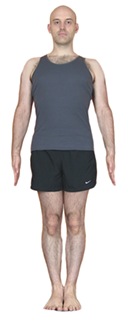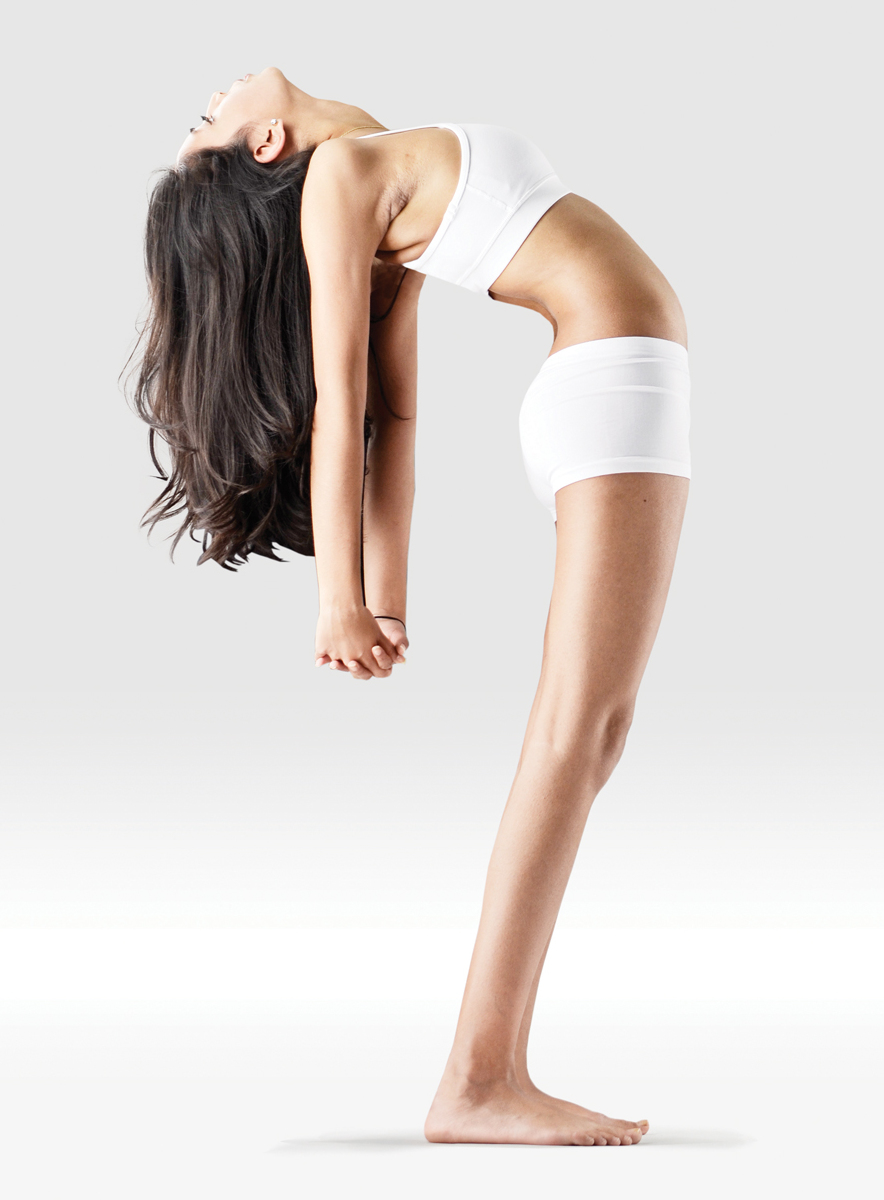Hasta Uttanasana on:
[Wikipedia]
[Google]
[Amazon]
 Tadasana ( sa , ताड़ासन, translit=Tāḍāsana), Mountain pose or Samasthiti ( sa, समस्थिति; IAST: ''samasthitiḥ'') is a standing asana in modern
Tadasana ( sa , ताड़ासन, translit=Tāḍāsana), Mountain pose or Samasthiti ( sa, समस्थिति; IAST: ''samasthitiḥ'') is a standing asana in modern

 Placing the feet wider is common in vinyasa styles of yoga and provides a more stable base in this and other such standing asanas.
Namaskarasana, Pranamasana, or Prayer Pose has the hands in prayer position (
Placing the feet wider is common in vinyasa styles of yoga and provides a more stable base in this and other such standing asanas.
Namaskarasana, Pranamasana, or Prayer Pose has the hands in prayer position (
 Tadasana ( sa , ताड़ासन, translit=Tāḍāsana), Mountain pose or Samasthiti ( sa, समस्थिति; IAST: ''samasthitiḥ'') is a standing asana in modern
Tadasana ( sa , ताड़ासन, translit=Tāḍāsana), Mountain pose or Samasthiti ( sa, समस्थिति; IAST: ''samasthitiḥ'') is a standing asana in modern yoga as exercise
Yoga as exercise is a physical activity consisting mainly of postures, often connected by flowing sequences, sometimes accompanied by breathing exercises, and frequently ending with relaxation lying down or meditation. Yoga in this form has ...
; it is not described in medieval hatha yoga texts. It is the basis for several other standing asanas.
Etymology and origins
Tāḍāsana is from the Sanskrit words ताड ''tāḍa'', "mountain" and आसन ''āsana'' meaning "posture" or "seat". Samasthitiḥ is from सम ''sama'' meaning "equal", level", or "balanced"; and स्थिति ''sthiti'', "standing". The pose was unknown in hatha yoga until the 20th century '' Light on Yoga'', but it appears in the 1896 ''Vyayama Dipika'', a manual ofgymnastics
Gymnastics is a type of sport that includes physical exercises requiring balance, strength, flexibility, agility, coordination, dedication and endurance. The movements involved in gymnastics contribute to the development of the arms, legs, s ...
, as part of the "very old" sequence of ''danda'' (Sanskrit for "staff" or "stick") exercises. Norman Sjoman
Norman E. Sjoman (born July 6, 1944, Mission City) is known as author of the 1996 book ''The Yoga Tradition of the Mysore Palace'', which contains an English translation of the yoga section of ''Sritattvanidhi'', a 19th-century treatise by the ...
suggests that it was among the poses adopted into modern yoga as exercise
Yoga as exercise is a physical activity consisting mainly of postures, often connected by flowing sequences, sometimes accompanied by breathing exercises, and frequently ending with relaxation lying down or meditation. Yoga in this form has ...
in Mysore
Mysore (), officially Mysuru (), is a city in the southern part of the state of Karnataka, India. Mysore city is geographically located between 12° 18′ 26″ north latitude and 76° 38′ 59″ east longitude. It is located at an altitude of ...
by Krishnamacharya to form the "primary foundation" for his vinyasas with flowing movements between poses. The pose was then taken up by his pupils Pattabhi Jois and B. K. S. Iyengar, into their worldwide Ashtanga Vinyasa Yoga and Iyengar Yoga styles respectively.
Description
Tadasana is the basic standing asana on which many other poses are founded. The feet are together and the hands are at the sides of the body. The posture is entered by standing with the feet together, grounding evenly through the feet and lifting up through the crown of the head. The thighs are lifted, the waist is lifted, and the spine is elongated. The breathing is relaxed. It is used in some schools of yoga in between other poses, to allow the body and consciousness to integrate the experience of the preceding asana and to prepare for the next. Asanas that help prepare for Tadasana include Adho Mukha Svanasana andUttanasana
Uttanasana ( sa, उत्तानासन; ) or Standing Forward Bend, with variants such as Padahastasana where the toes are grasped, is a standing forward bending asana in modern yoga as exercise.
Etymology and origins
The name comes from ...
.
Variations

 Placing the feet wider is common in vinyasa styles of yoga and provides a more stable base in this and other such standing asanas.
Namaskarasana, Pranamasana, or Prayer Pose has the hands in prayer position (
Placing the feet wider is common in vinyasa styles of yoga and provides a more stable base in this and other such standing asanas.
Namaskarasana, Pranamasana, or Prayer Pose has the hands in prayer position (Anjali mudra '' (Devanagari: अञ्जली; अंजली) is a Sanskrit word that means " divine offering". It is not only a given name, but also the name given to the greeting between Hindus, Buddhists and other religions on the Indian subcontinent: ha ...
) in front of the chest.
Pashchima Namaskarasana or Reverse Prayer Pose has the hands in prayer position behind the back.
Urdhva Vrikshasana
Tree pose or Vrikshasana ( sa, वृक्षासन, translit=vṛkṣāsana) is a balancing asana. It is one of the very few standing poses in medieval hatha yoga, and remains popular in modern yoga as exercise. The pose has been called ico ...
, also called Urdhva Hastasana or upward tree pose, has the hands stretched straight upwards, and the gaze is upward to the Angusthamadhye Drishti (thumbs). The pose occurs twice in Ashtanga Yoga's Surya Namaskar
Sun Salutation, also called Surya Namaskar(a) or Salute to the Sun (), is a practice in yoga as exercise incorporating a flow sequence of some twelve gracefully linked asanas. The asana sequence was first recorded as yoga in the early 20th centu ...
.
Parshvasana (Side Stretch Pose), also called Indudalasana, known from 1968, has the arms lifted and the body stretched over to one side.
Anuvittasana or Hasta Uttanasana (Standing Back Bend), has the arms raised and the back arched. An extreme form of the pose is Tiryang Mukhottanasana, in which the back bend is sufficient to enable the hands to grasp the ankles.
Some reclining asanas such as Supta Tadasana (Reclined Mountain Pose) stem from Tadasana.
Iyengar Yoga
Iyengar Yoga considers Tadasana pivotal as the foundation of most standing asanas. It teaches practitioners to balance the weight equally on the two feet.The feet are placed together, the shins and thighs are aligned, and the chest is lifted. The pose is not distinguished from Samasthitih. The arms can be raised over the head or kept at the sides of the legs. It appears in the 1st and 2nd weeks of Iyengar's āsana courses as detailed in '' Light on Yoga''.Ashtanga Vinyasa Yoga
In Ashtanga Vinyasa Yoga, Tadasana is performed on the toes, while Samasthitiḥ is flat footed. In this style of yoga the two āsanas are different. Samasthitiḥ is the centerpiece of the standing sequence and the foundation for the Hasta Vinyasas (arm vinyasas), Parsva Bhangi (side) vinyasas,Uttanasana
Uttanasana ( sa, उत्तानासन; ) or Standing Forward Bend, with variants such as Padahastasana where the toes are grasped, is a standing forward bending asana in modern yoga as exercise.
Etymology and origins
The name comes from ...
(forward bending) vinyasas, and squatting/hip stretching asanas. In the standing sequence, the final asana of the series (before Savasana
Shavasana ( sa, शवासन; IAST: ''śavāsana''), Corpse Pose, or Mritasana, is an asana in hatha yoga and modern yoga as exercise, often used for relaxation at the end of a session. It is the usual pose for the practice of yoga nidra medita ...
) is Tadasana, performed on the toes. In this school of yoga, Tadasana is the beginning and ending asana in the warm-up Surya Namaskar
Sun Salutation, also called Surya Namaskar(a) or Salute to the Sun (), is a practice in yoga as exercise incorporating a flow sequence of some twelve gracefully linked asanas. The asana sequence was first recorded as yoga in the early 20th centu ...
sequence. It is sometimes interspersed throughout Ashtanga Series when full vinayasas are used, and it is the foundational pose for all standing asanas. The Nasagra Drishti at the tip of the nose is considered the correct drishti for Tadasana. Sushumna drishti is encouraged to draw the awareness inward. The school considers Uddiyana bandha, Mula Bandha
A bandha ( sa, बंध) is a kriyā in Hatha Yoga, being a kind of internal mudra described as a "body lock," to lock the vital energy into the body. ''Bandha'' literally means bond, fetter, or "catching hold of".Iyengar, 1976: pp.435–437
Mah ...
and Jalandhara Bandha appropriate for Tadasana.
See also
*List of asanas
An asana is a body posture, used in both medieval hatha yoga and modern yoga. The term is derived from the Sanskrit word for 'seat'. While many of the oldest mentioned asanas are indeed seated postures for meditation, asanas may be standing, seat ...
References
Sources
* * * * * * * * {{DEFAULTSORT:Tadasana Standing asanas Surya Namaskar